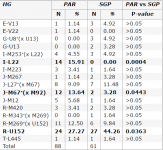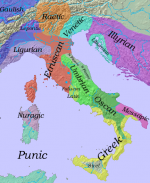Angela
Elite member
- Messages
- 21,823
- Reaction score
- 12,329
- Points
- 113
- Ethnic group
- Italian
This is another Boattini, Sarno et al paper. They use uniparental markers, especially the "Y" chromosome (str and snp markers), surname analysis, and extensive genealogical records to attempt a recreation of early medieval historical migration patterns into a subset of the Emilia-Romagna population, i.e. the members of "Partecipenze" near Bologna.
See:
Traces of medieval migrations in a socially stratified population from Northern Italy. Evidence from uniparental markers and deep-rooted pedigrees
http://www.nature.com/hdy/journal/v114/n2/full/hdy201477a.html
"Social and cultural factors had a critical role in determining the genetic structure of Europe. Therefore, socially stratified populations may help to focus on specific episodes of European demographic history. In this study, we use uniparental markers to analyse the genetic structure ofPartecipanza in San Giovanni in Persiceto (Northern Italy), a peculiar institution whose origins date back to the Middle Ages and whose members form the patrilineal descent of a group of founder families. From a maternal point of view (mtDNA), Partecipanza is genetically homogeneous with the rest of the population. However, we observed a significant differentiation for Y-chromosomes. In addition, by comparing 17 Y-STR profiles with deep-rooted paternal pedigrees, we estimated a Y-STR mutation rate equal to 3.90 * 10−3 mutations per STR per generation and an average generation duration time of 33.38 years. When we used these values for tentative dating, we estimated 1300-600 years ago for the origins of the Partecipanza. These results, together with a peculiar Y-chromosomal composition and historical evidence, suggest that Germanic populations (Lombards in particular) settled in the area during the Migration Period (400–800 ad, approximately) and may have had an important role in the foundation of this community."
"Partecipanze are an absolutely idiosyncratic way of sharing and devolving collective lands. These institutions originated in the Middle Ages and are still present in some areas of Northern Italy. The privilege to participate (i.e., to share the leased assets) is inherited following a gene-like pattern through exclusive admission granted to the descent of a group of founder families, usually following the paternal line (Zanarelli, 1992). In this way, the members of Partecipanza conserved through the centuries their social and economic identity, potentially together with some of their genetic features."
The Supplementary Info can be found here:http://www.nature.com/hdy/journal/v114/n2/suppinfo/hdy201477s1.html
Among the people of this area near Bologna two y haplogroups have higher frequency among the elite "partecipanza" group than in the control group from the same area: I-L22 (16% vs 0), and J-M67(xM92) (14% vs 3%). U-152, although the most numerous both among the elite group and the control group, is lower among the elite group than among the control group (27% vs. 44%),
View attachment 7675
Given the history of the partecipenza system in the area and its ties to a monastery established by the Lombards, plus the dating they've done, the authors have the following to say:
"Putting it all together, it seems plausible to relate historical and archaeological information with our molecular results, suggesting that a Lombard component may have had a key role in the foundation of Partecipanza."
I do think they're right in saying this is not some fossil population of Lombards. For one thing, as they put it, "Their [the Lombard] original genetic variability is still unknown and probably varied in time and space", and for another, the mtDna seems to be similar across all groups, so autosomally I doubt there would be much difference.
I find the yDna J-M67(xM22) particularly interesting. There are two clusters, one which they date to about 6000 BC, and which is present in both the "Partecipanza group" and the control group, and also in Germany, and one represented only in the elite group and only in one pedigree, whose closest modal haplotype they found in Apulia. I'm unsure what to make of this. Was the "J" found in the Indo-European warrior J-M67? Could it have entered Italy from the north? Or is this group in both Italy and Germany from the same migration that brought J2 to Sopot? I think that was also J-M67. What of the southern affiliated group?
Fwiw: this is what I could find on J-M67. If someone knows anything more specific, especially about the xM22 group, that would be great.
"J-M67J-M67 (Called J2f in older papers) has its highest frequencies associated with Nakh peoples. Found at very high (majority) frequencies among Ingush in Malgobek (87.4%), Chechens in Dagestan (58%), Chechens in Chechnya (56.8%) and Chechens in Malgobek, Ingushetia (50.9%) (Balanovsky 2011). In the Caucasus, it is found at significant frequencies among Georgians (13.3%) (Semino 2004), Iron Ossetes (11.3%), South Caucasian Balkars (6.3%) (Semino 2004), Digor Ossetes (5.5%), Abkhaz (6.9%), and Cherkess (5.6%) (Balanovsky 2011). It is also found at notable frequencies in the Mediterranean and Middle East, including Cretans (10.2%), North-central Italians (9.6%), Southern Italians (4.2%; only 0.8% among N. Italians), Anatolian Turks (2.7-5.4%), Greeks (4-4.3%), Albanians (3.6%), Ashkenazi Jews (4.9%), Sephardis (2.4%), Catalans (3.9%), Andalusians (3.2%), Calabrians (3.3%), Albanian Calabrians (8.9%) (see Di Giacomo 2004 and Semino 2004)."
There are many groups of U-152, all dating to 5,000-4000 years ago.
As interesting as this is in terms of migrations, it's also interesting about what it says about social stratification. Are we looking at an ascendancy in this area at least since the 1500s, and probably back at least a thousand or fifteen hundred years before that?
This is part of what I meant when I said that the New World offered an opportunity for upward mobility that wasn't present in the Old World.
See:
Traces of medieval migrations in a socially stratified population from Northern Italy. Evidence from uniparental markers and deep-rooted pedigrees
http://www.nature.com/hdy/journal/v114/n2/full/hdy201477a.html
"Social and cultural factors had a critical role in determining the genetic structure of Europe. Therefore, socially stratified populations may help to focus on specific episodes of European demographic history. In this study, we use uniparental markers to analyse the genetic structure ofPartecipanza in San Giovanni in Persiceto (Northern Italy), a peculiar institution whose origins date back to the Middle Ages and whose members form the patrilineal descent of a group of founder families. From a maternal point of view (mtDNA), Partecipanza is genetically homogeneous with the rest of the population. However, we observed a significant differentiation for Y-chromosomes. In addition, by comparing 17 Y-STR profiles with deep-rooted paternal pedigrees, we estimated a Y-STR mutation rate equal to 3.90 * 10−3 mutations per STR per generation and an average generation duration time of 33.38 years. When we used these values for tentative dating, we estimated 1300-600 years ago for the origins of the Partecipanza. These results, together with a peculiar Y-chromosomal composition and historical evidence, suggest that Germanic populations (Lombards in particular) settled in the area during the Migration Period (400–800 ad, approximately) and may have had an important role in the foundation of this community."
"Partecipanze are an absolutely idiosyncratic way of sharing and devolving collective lands. These institutions originated in the Middle Ages and are still present in some areas of Northern Italy. The privilege to participate (i.e., to share the leased assets) is inherited following a gene-like pattern through exclusive admission granted to the descent of a group of founder families, usually following the paternal line (Zanarelli, 1992). In this way, the members of Partecipanza conserved through the centuries their social and economic identity, potentially together with some of their genetic features."
The Supplementary Info can be found here:http://www.nature.com/hdy/journal/v114/n2/suppinfo/hdy201477s1.html
Among the people of this area near Bologna two y haplogroups have higher frequency among the elite "partecipanza" group than in the control group from the same area: I-L22 (16% vs 0), and J-M67(xM92) (14% vs 3%). U-152, although the most numerous both among the elite group and the control group, is lower among the elite group than among the control group (27% vs. 44%),
View attachment 7675
Given the history of the partecipenza system in the area and its ties to a monastery established by the Lombards, plus the dating they've done, the authors have the following to say:
"Putting it all together, it seems plausible to relate historical and archaeological information with our molecular results, suggesting that a Lombard component may have had a key role in the foundation of Partecipanza."
I do think they're right in saying this is not some fossil population of Lombards. For one thing, as they put it, "Their [the Lombard] original genetic variability is still unknown and probably varied in time and space", and for another, the mtDna seems to be similar across all groups, so autosomally I doubt there would be much difference.
I find the yDna J-M67(xM22) particularly interesting. There are two clusters, one which they date to about 6000 BC, and which is present in both the "Partecipanza group" and the control group, and also in Germany, and one represented only in the elite group and only in one pedigree, whose closest modal haplotype they found in Apulia. I'm unsure what to make of this. Was the "J" found in the Indo-European warrior J-M67? Could it have entered Italy from the north? Or is this group in both Italy and Germany from the same migration that brought J2 to Sopot? I think that was also J-M67. What of the southern affiliated group?
Fwiw: this is what I could find on J-M67. If someone knows anything more specific, especially about the xM22 group, that would be great.
"J-M67J-M67 (Called J2f in older papers) has its highest frequencies associated with Nakh peoples. Found at very high (majority) frequencies among Ingush in Malgobek (87.4%), Chechens in Dagestan (58%), Chechens in Chechnya (56.8%) and Chechens in Malgobek, Ingushetia (50.9%) (Balanovsky 2011). In the Caucasus, it is found at significant frequencies among Georgians (13.3%) (Semino 2004), Iron Ossetes (11.3%), South Caucasian Balkars (6.3%) (Semino 2004), Digor Ossetes (5.5%), Abkhaz (6.9%), and Cherkess (5.6%) (Balanovsky 2011). It is also found at notable frequencies in the Mediterranean and Middle East, including Cretans (10.2%), North-central Italians (9.6%), Southern Italians (4.2%; only 0.8% among N. Italians), Anatolian Turks (2.7-5.4%), Greeks (4-4.3%), Albanians (3.6%), Ashkenazi Jews (4.9%), Sephardis (2.4%), Catalans (3.9%), Andalusians (3.2%), Calabrians (3.3%), Albanian Calabrians (8.9%) (see Di Giacomo 2004 and Semino 2004)."
There are many groups of U-152, all dating to 5,000-4000 years ago.
As interesting as this is in terms of migrations, it's also interesting about what it says about social stratification. Are we looking at an ascendancy in this area at least since the 1500s, and probably back at least a thousand or fifteen hundred years before that?
This is part of what I meant when I said that the New World offered an opportunity for upward mobility that wasn't present in the Old World.
Attachments
Last edited:






